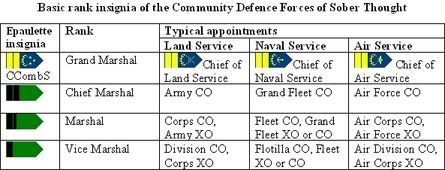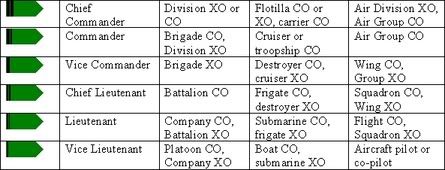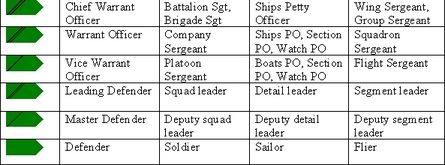CDF ranks
The Community Defence Forces of Sober Thought, like most hierarchies and especially military hierarchies, has an ordered (but usually not truly stratified) structure of superiors and subordinates. Among the related but distinct concepts associated with rank are pay grade, equivalence, appointment, branch, insignia and posting.
Although it seems complex, it is easily grasped using definitions, examples and illustrations below. Furthermore, as an egalitarian society of practically minded people, members of the CDF are not nearly as obsessed with these concepts as this article might suggest. So long as the job gets done, the nation’s soldiers, sailors and fliers of all ranks don’t really care overy much about the official trappings.
Contents
Types of rank
At its most basic level, rank indicates where one belongs in the armed forces’ food chain. It allows those normally working together, those rarely working together and those outside the military structure to get a fair idea of what one’s responsibilities are with the least amount of explanation. However, once one moves beyond this level, the waters quickly become murkier. Substantive rank indicates the permanent rank one has achieved and from which one cannot be demoted without cause.
Temporary rank, as its name applies, does not have the permanence of substantive rank. Soldiers of any rank may be promoted beyond their substantive ranks for a specific task, to ensure equality with allies, as part of a rapid but shortterm expansion of the armed forces, as a courtesy or honour, etc. The promotion lasts as long as the CDF sees fit, and it can be reversed without cause at any time.
Brevet rank is the residual evidence of temporary rank and reversion to substantive rank. For instance, a substantive naval Commander may be elevated to the temporary rank of Chief Commander while directing a task force including many land and air troops not normally associated with the CDF Naval Service. Upon completion of the mission and disbandment of the task force, the acting chief commander reverts to the substantive rank of Commander but for courtesy purposes may be addressed by the former rank.
Pay grade
In a less complicated era, rank was also an excellent predictor of pay. For instance, when the army was made up almost entirely of infantry units, one lieutenant would get the same pay as any other lieutenant. However, as armed forces became more specialised, additional pay was added for those with greater technical training, longer years of service, differing family status, service in a combat zone, added responsibilities, etc.
In the real world, many armed forces attempted to deal with this problem by rank inflation: as the role increased in value so did the rank. An unfortunate byproduct of this policy was the debasement of rank, and a growing disconnect between rank and responsibility. So-called desk officers, while performing important staff and senior command roles, achieved ranks grossly out of proportion to the people they supposedly led. And once rank inflation starts, it is difficult to stop so it tends to accellerate.
In fact, RL American forces encourage this process by an "upwards or outwards" policy, i.e., those officers who are not promoted are ejected from the forces. As one American officer lamented, every 2nd Lieutenant had to be treated as a potential Chairman of the Joint Chiefs of Staff and given all kinds of staff training and sinecure positions so they would not be forced out. Sober Thought regards this policy as unreasonably costly and ineffective. There are many junior officers who are highly skilled as platoon leaders but should never be elevated to staff positions or senior field command, but why force competent officers out? And if they officers are truly incompetent or inappropriate, why wait for years when you can discharge them with cause so much earlier?
To cite a Commonwealth example, British army Captains had for centuries been company commanders and subalterns (Lieutenants and Second Lieutenants) their platoon commanders. The basic unit was the regiment, consisting of two flak or specialist and eight field companies, each of the ten companies consisting of two platoons. The senior officers of the regiment were the Colonel, Lieutenant Colonel and Major. However, in the 19th century, the regiment kept the same number of personnel but reorganised into one specialist and four field companies, each of four platoons. Consequently, the amalgamation of two small companies in one large one created a glut of Captains. Senior command solved this problem by promoting the senior Captain to the rank of Major and retaining the other as deputy commander in their original rank.
Over the course of the 20th century, as platoons became more specialised, such as reconnaissance or mortars, many Commonwealth countries could not resist making those platoon commanders into Captains. They disingenuously argued that the firepower of a modern platoon was greater than that of an entire regiment or battalion of yesteryear. While true, it neglected the fact that all the other armies had increased their firepower so there was little or no relative difference. By such an incremental process and without any long range or explicit planning, the rank of Captain was debased and its status garnered over centuries was irreparably tarnished.
Current and historic ranks
There are few RL countries which have fully integrated all their armed forces into one. Most have two to five separate arms of service -- army, navy, air force, marines, coast guard, air defence forces, gendarme, rocket troops and militia being among the most common -- each with their distinctive ranks. Even within a single supposedly unified arm of service might have parallel rank structures, such as the American and British navies with regards to their marines.
Sober Thought was no different. It had three arms of service, now represented in the unified service as the CDF Land Service (army), CDF Naval Service (navy, including marines with a rank structure similar to that of the army) and CDF Air Service (air force). What is more, all three of the armed forces slid down the slippery slope of rank inflation. However, even then they did not plumb the depths of most RL armed forces. For instance the various services eliminate the needless division of army subalterns into classes of lieutenants and never implemented the absurdity of creating the substantive naval rank of Acting Sub-Lieutenant so that equivalency with Second Lieutenant were possible.
For operational and budgetary reasons, Sober Thought eventually decided to unify its separate arms of service like RL Canada and Israel. Simultaneously, it took the opportunity to enforce rank deflation upon its armed forces when they integrated. Newly minted, or more accurately synthesised, ranks reduced or removed the understandable reluctance of soldiers, sailors and fliers to relinquish their hard-earned promotions. By making these changes wholesale, no one person was singled out and the restoration of rank's value benefitted all.
In the convenient table below, pay grades on the far left of each row offset the arms of service in each column. Note the counterintuitive listing for the warrant officer group, in which a Warrant Officer 1st Class is listed in the W-3 pay grade. These national pay grades for officers are typically one number below standard American and NATO grades with similar names. And the enlisted ranks or grades deviate further, since the United States and the Commonwealth have an entirely different conception of Warrant Officers, the former seeing them as specialist officers in the process of receiving proper commissions and the latter seeing them as senior non-commissioned officers of long service. Furthermore, the Commonwealth is much more likely to deal with senior or specialist warrant officers by adding a new appointment rather than an actual rank as the United States is prone to do.
Preunification services largely followed the Commonwealth model, and avoided some of the more perverse absurdities of the Anglo-American models. The rank of Recruit, Private Recruit or similar for those who have been inducted into the armed forces but have not yet finished their training does not exist. And since minors are forbidden to join the armed forces, the rank of Boy, Boy Soldier, Cabin Boy or similar used for such tasks as the regimental band or orderly duties does not exist. Likewise, the United States Navy ranks of Rear Admiral (Upper Half) = Rear Admiral, Rear Admiral (Lower Half) = Commodore, and Lieutenant (Junior Grade) = Sub-Lieutenant are avoided.
| CDF English | CDF French | Former army and marines | Former navy | Former air force | |
|---|---|---|---|---|---|
| O-10 | Grand Marshal | Grand Maréchal | Field Marshal | Admiral of the Fleet | Marshal of the Air Force |
| O-9 | Chief Marshal | Maréchal chef | General | Admiral | Air Chief Marshal |
| O-8 | Marshal | Maréchal | Lieutenant General | Vice Admiral | Air Marshal |
| O-7 | Vice Marshal | Maréchal adjoint | Major General | Rear Admiral | Air Vice Marshal |
| O-6 | Chief Commander | Commandant chef | Brigadier General | Commodore | Air Commodore |
| O-5 | Commander | Commandant | Colonel | Captain | Group Captain |
| O-4 | Vice Commander | Commandant adjoint | Lieutenant Colonel | Commander | Wing Commander |
| O-3 | Chief Lieutenant | Lieutenant chef | Major | Lieutenant Commander | Squadron Leader |
| O-2 | Lieutenant | Lieutenant | Captain | Lieutenant | Flight Lieutenant |
| O-1 | Vice Lieutenant | Lieutenant adjoint | Lieutenant | Sub-Lieutenant | Flying Officer |
| W-3 | Chief Warrant Officer | Adjudant chef | Warrant Officer I | Chief Petty Officer I | Warrant Officer I |
| W-2 | Warrant Officer | Adjudant | Warrant Officer II | Chief Petty Officer II | Warrant Officer II |
| W-1 | Vice Warrant Officer | Adjudant adjoint | Staff Sergeant | Petty Officer I | Flight Sergeant |
| E-3 | Leading Defender | Défenseur chef | Sergeant | Petty Officer II | Sergeant |
| E-2 | Master Defender | Défenseur maître | Corporal | Leading Sailor | Corporal |
| E-1 | Defender | Défenseur | Private | Able Seaman | Aircraftsman |
Examining the ranks in this manner helps show how the names in the newly unified force were chosen. The much larger army often deferred to its smaller and newer counterparts as part of a comprehensive attempt to assuage fears of a trashing of time-honoured traditions.
Those of the most senior officers, the marshal group, closely follow the pattern of the old air force and, to a much lesser extent, the army. Those of the middling officers, the commander group, broadly follow the navy and air force patterns. Those of the most junior officers, the lieutenant group, have the greatest agreement in the following order: navy, air force and army.
Appointment
Another important concept to grasp is that of appointment, which is distinct from both rank discussed above and Posting discussed below. It is helpful to think of an appointment as a combination of a pseudo-rank and a longterm posting.
In most countries, the most obvious place to spot these differences is among the non-commissioned officers and ordinary troops. At the lowest level, many RL and Sober Thought soldiers carry a designation specific their regiment. E.g., the following people could hold the same rank as private: a Guardsman in The Governor General’s Foot Guard of Canada, a Lance Bombardier in the Royal Australian Artillery, a Panzergrenadier in the German 11. Panzergrenadierregiment, an Aircraftsman 2nd Class in the Royal New Zealand Air Force and a Driver in the Indian Army Service Corps.
At the level of warrant officer, comparable to senior non-commissioned officers in other armed forces like the United States and Germany, the number of variations in the name of appointments is incomparably greater. In Commonwealth armies, for instance, the rank of Warrant Officer 1st Class encompasses (among others) the Master Gunner 1st Class, Regimental Sergeant Major and Conductor of the Army Service Corps appointments. Both officers and ordinary soldiers would never address such persons by their rank, unless they had absolutely no prior acquaintance, but rather by their appointment.
The most senior Commonwealth sergeants typically hold a rank of staff sergeant (sometimes converted to Warrant Officer III), created in the early 19th century to reward sergeants with long service and proven command ability. This was before commissioning from the ranks was permitted since the sale of ranks and the lack of military competence it encouraged continued until shortly after the Crimean War of mid-century. They are or have been known variously as Colour Sergeants, Troop Sergeant Majors, Company Quartermaster Sergeants, Flight Sergeants in the air force and many others.
Among the three classes of CDF warrant officers, there are a number of distinguishing geometric figures below their epaulette stripe which indicate appointment. Among Vice Warrant Officers, an equilateral triangle indicates a Platoon Sergeant (land), a Flight Sergeant (air) and a Section Petty Officer (navy), and an equilateral triangle on a base of a semi-circle a Watch Petty Officer (navy). Among Warrant Officers, a square indicates a Company Sergeant (land), a Squadron Sergeant (air) and a Boats Petty Officer (navy), and a square on a base of a semi-circle a Watch Petty Officer (navy). Among Chief Warrant Officers, a pentagon indicates a Battalion Sergeant (land) and a Wing Sergeant (air), a diamond a Ships Petty Officer, and a hexagon a Brigade Sergeant (land) and a Group Sergeant (air).
Appointment in the ranks equivalent to junior NCOs are Leading Soldier (land), Leading Sailor (naval), Leading Flier (air), Master Soldier, Master Sailor and Master Flier. The ranks equivalent to private soldiers are Solider, Sailor and Flier. In fact, these appointments have become so ingrained that even in official communications they are often used interchangeably with ranks even thought they are not.
Among officers, a few vestiges of past appointments continue in a semi-official capacity. For instance, the most junior Vice Lieutenant of a company, flight or ship at least equal to a cruiser is called an ensign, which is a RL rank in the United States Navy and Coast Guard equivalent to the absurd Commonwealth navies one of Acting Sub-Lieutenant. The most senior “captain” (see Appointment below) of vessels of similar size in the Naval Service is called “commodore,” a preunification appointment-cum-rank just below Rear Admiral.
Branch
As one can see in previous examples, each regiment, corps or branch of service often develops its own traditions or retains archaic terminology others abandon. Sometimes this extends to the forms of dress, for instance the kilted-and-tamed Highlanders in Britain, the feathered Alpini in Italy or the bearskinned Kongelige Livgarde of Denmark. But in nearly all cases, it expends to less extreme forms like cap badges, shoulder flashes, epaulettes, collar insignia or any combination thereof.
This is true of Sober Thought’s Community Defence Forces as well, where merging of arms of service was designed to enhance interoperability rather than needlessly crush cherished local traditions. Many branches transferred over with little change, and even those that required some adjustment generally met with the approval of serving if not always retired soldiers, sailors and fliers.





Insignia
As the illustrations in the previous section anticipate, rank may be meaningful in the abstract, but what good is it nobody knows where one fits in the pecking order? This problem is remedied by rank insignia, a graphical representation of ranks which is understandable to friend and, if possible, not to foe. Even before unification, the armed forces had dispensed with salutes and outward ostentatious displays of rank; discrete insignia not immediately obvious to enemy snipers were the preferred means of indicating rank.
All troops show rank on their epaulettes, along with insignia indicating branch or service. Field uniforms are olive green and dress uniforms mid-blue. Troops serving with the Combined Staff always have their branches and ranks in gold. Other troops always have their branches in grey, and their ranks in black for field and white for dress uniforms.



See how this graphic chart conforms to the structure of the tabular data of current and historic ranks listed above.
Posting
One may arrive at the concept of posting via appointment, branch or both. Generally speaking, a posting is the specific job to which a soldier, sailor or flier has been assigned to fill; what the navy used to refer to as one's billet.
The most senior officers are the four marshal ranks, generally commanding a large formation intended to operate without outside assistance. The mid-level officers are the three commander ranks, generally commanding a small formation or unit intended to operate as part of a larger formation. The junior officers are the three lieutenant ranks, generally commanding a small unit or sub-unit reporting to a larger formation or unit.
Each of the three unified services refers to the ranking officer in a formation or unit as "commanding officer." The second ranking officer or deputy commanding officer is called "executive officer." However, in keeping with maritime traditions, the Naval Service may unofficially but widely adopt the term "captain" or even “skipper” as a synonym for the commanding officer of a vessel (boat or ship) or stone frigate (shore installation or naval base). Since there are no longer ranks including the word "captain" – confusingly ranking as an O-2 in the preunification army and an O-5 in the navy and air force -- this causes no confusion.
Much more rarely, one hears of the “air officer commanding’’ in the Air Service. However, the preunfication ranks are used to describe posting (which they no longer did when the forces merged). For instance, in the old air force most squadron commanding officers paradoxically held the rank of Wing Commander rather than Squadron Leader, to keep air squadrons on par with army battalions which were commanded by Lieutenant Colonels. Under the new system, posting and old rank were back in sync so informal or jocular usage of the old ranks makes sense.
